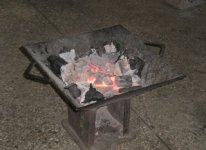JasonPAtkins
Hot Rolled
- Joined
- Sep 30, 2010
- Location
- Guinea-Bissau, West Africa
Hey all,
I run a little non-profit fab and machining school in West Africa. I'm always on the lookout for products that my students can make to sell locally that are going to have a better combination of utility / price / quality than the sub-Harbor Freight quality garbage that's imported from China for sale there.
Masonry is ubiquitous in that world. Trowels are available, but break often because they're pretty cheap. The shop I've built is pretty well stocked, and I'm wondering if the need for a good trowel could dovetail nicely with some of the capabilities my shop has - in this case the plasma table and spot welder. I can imagine cutting the trowel plates from sheet, several hundred per run, and then spot welding some kind of fabricated handle onto them - seems like it could be a pretty quick process in quantity.
However, I have only passing familiarity with what makes a brick trowel good or bad. The failure point of most of the cheap ones I see over there is the handle breaking apart from the base plate.
I started doing some research, and the W.Rose trowels that retail for $50 here in the States and seem to be close to the gold standard are forged from bar, not done the way I'm envisioning. Does anyone know how the $20 trowels are made?
I'd love any input, but the most specific question I'm wondering (and why I'm asking on PM instead of WeldingWeb) is: does anyone know what kind of steel the blade of a trowel would be made from? I fear that mild steel sheet is not going to have the spring required for this application. If true, that will start and end the project, because we can't buy anything other than plain mild steel. Trowels could still be made over there, but it would be a blacksmithing-from-leaf-spring-steel project - squarely outside of both my shop's expertise and equipment.
I run a little non-profit fab and machining school in West Africa. I'm always on the lookout for products that my students can make to sell locally that are going to have a better combination of utility / price / quality than the sub-Harbor Freight quality garbage that's imported from China for sale there.
Masonry is ubiquitous in that world. Trowels are available, but break often because they're pretty cheap. The shop I've built is pretty well stocked, and I'm wondering if the need for a good trowel could dovetail nicely with some of the capabilities my shop has - in this case the plasma table and spot welder. I can imagine cutting the trowel plates from sheet, several hundred per run, and then spot welding some kind of fabricated handle onto them - seems like it could be a pretty quick process in quantity.
However, I have only passing familiarity with what makes a brick trowel good or bad. The failure point of most of the cheap ones I see over there is the handle breaking apart from the base plate.
I started doing some research, and the W.Rose trowels that retail for $50 here in the States and seem to be close to the gold standard are forged from bar, not done the way I'm envisioning. Does anyone know how the $20 trowels are made?
I'd love any input, but the most specific question I'm wondering (and why I'm asking on PM instead of WeldingWeb) is: does anyone know what kind of steel the blade of a trowel would be made from? I fear that mild steel sheet is not going to have the spring required for this application. If true, that will start and end the project, because we can't buy anything other than plain mild steel. Trowels could still be made over there, but it would be a blacksmithing-from-leaf-spring-steel project - squarely outside of both my shop's expertise and equipment.




 )
)